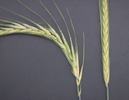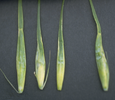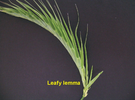International Database for Barley Genes and Barley Genetic Stocks
BGS 235, Leafy lemma 1, lel1
Stock number: BGS 235
Locus name: Leafy lemma 1
Locus symbol: lel1
Previous nomenclature and gene symbolization:
Leafy lemma = lel (1).
Inheritance:
Monofactorial recessive, but a second gene lel2 , which should have been identified as lks5.f (2, 3, 4), is required for expression of leafy lemma phenotype (1, 5).
Located in chromosome 1HL (2); ); lel1.a is associated with SNP markers 1_0876 to 2_0943 (positions 161.08 to 237.13 cM) in 2H bins 11 to 14 of Bowman backcross-derived line BW474 (2). The second gene required for leafy lemma expression is associated with SNP markers 2_1122 to 1_1019 (positions 47.8 to 183.54 cM) in 4H bins 05 to 13 of the Bowman backcross-derived line BW474 and with SNP markers 2_0422 to 2_0072 (positions 38.41 to 95.92 cM) in 4H bins 04 to 09 of the Bowman backcross-derived line BW475 (2). The lel1.a mutant was previously located in chromosome 1HL (5); about 6.1 cM distal from molecular marker MWG733 in 1H bin 12.
Located in chromosome 1HL (2); ); lel1.a is associated with SNP markers 1_0876 to 2_0943 (positions 161.08 to 237.13 cM) in 2H bins 11 to 14 of Bowman backcross-derived line BW474 (2). The second gene required for leafy lemma expression is associated with SNP markers 2_1122 to 1_1019 (positions 47.8 to 183.54 cM) in 4H bins 05 to 13 of the Bowman backcross-derived line BW474 and with SNP markers 2_0422 to 2_0072 (positions 38.41 to 95.92 cM) in 4H bins 04 to 09 of the Bowman backcross-derived line BW475 (2). The lel1.a mutant was previously located in chromosome 1HL (5); about 6.1 cM distal from molecular marker MWG733 in 1H bin 12.
Description:
The overall shape of the leafy lemma is similar to that of the typical, but miniature, grass leaf. The leafy lemma has a basal zone that is wider and more elongated, a transition zone, and a distal domain similar in shape to a leaf blade (1, 5). In all crosses analyzed, F2 lel1 plants always had awnless lemmas, the caryopsis was longer than normal and was partially naked, there was a tendency for the rachilla to bear more than one floret, and rachis internodes were elongated (5). The lks2 gene was reported as required for full expression of the leafy lemma phenotype (5), but the short variant isolated from the leafy lemma stock was allelic at the lks5 locus (3). The second mutant isolated from original stock was identified as lel2.b (2), but a review of Gerd Bossinger’s Thesis (4), allelism tests (3), and molecular marker data (2) indicated that the second gene is lks5.f. The kernels of BW474 were lighter, 4.6 vs 5.7 mg, test weights were 30 to 40% lower, and grain yield was about 50% lower (3).






Origin of mutant:
A spontaneous mutant isolated at the Istituto Sperimentale per la Cerealicoltura (Fiorenzuola, Italy) in a plot having a recessive mutant for short awn identified as the lks5 (short awn 5) line from the Small Grains Germplasm Research Facility (USDA-ARS), Aberdeen, Idaho (1, 4, 5).
Mutational events:
lel1.a (G7118, GSHO 1780) in short awn 5 (lks5.f) of an introduction (1, 2, 3, 4, 5). Reexamination of the original Ph.D. Thesis confirmed that the original stock in which the leaf mutant phenotype was isolated was introduced as an lks5 variant, likely lks5.f (GSHO 1297) from CIho 5641 (4).
Mutant used for description and seed stocks:
lel1.a (G7118, GSHO 1780) in an lks5.f stock (1, 4, 5); lel1.a in Bowman (PI 483237)*3 (GSHO 2279), lel1.a in Bowman*4 (BW474, NGB 20704). The second gene required of trait express, lks5.p, has been isolated from G7118 in Bowman*5 (BW475, NGB 20705) (2, 3, 4, 5).
References:
1. Bossinger, G., U. Lundqvist, W. Rohde, and F. Salamini. 1992. Genetics of plant development in barley. p. 989-1017. In L. Munck, K. Kirkegaard, and B. Jensen (eds.). Barley Genetics VI. Proc. Sixth Int. Barley Genet. Symp., Helsingborg, 1991. Munksgaard Int. Publ., Copenhagen.
2. Druka, A., J. Franckowiak, U. Lundqvist, N. Bonar, J. Alexander, K. Houston, S. Radovic, F. Shahinnia, V. Vendramin, M. Morgante, N. Stein, and R. Waugh. 2011. Genetic dissection of barley morphology and development. Plant Physiol. 155:617-627.
3. Franckowiak, J.D. (Unpublished).
4. Lundqvist, U. (Unpublished). (Based on a re-examination of Gerd Bossinger’s Ph.D Thesis.).
2. Pozzi, C., P. Faccioli, V. Terzi, A.M. Stanca, S. Cerioli, P. Castiglioni, R. Fink, R. Capone, K.J. Müller, G. Bossinger, W. Rohde, and F. Salamini. 2000. Genetics of mutations affecting the development of a barley floral bract. Genetics 154:1335-1346.
2. Druka, A., J. Franckowiak, U. Lundqvist, N. Bonar, J. Alexander, K. Houston, S. Radovic, F. Shahinnia, V. Vendramin, M. Morgante, N. Stein, and R. Waugh. 2011. Genetic dissection of barley morphology and development. Plant Physiol. 155:617-627.
3. Franckowiak, J.D. (Unpublished).
4. Lundqvist, U. (Unpublished). (Based on a re-examination of Gerd Bossinger’s Ph.D Thesis.).
2. Pozzi, C., P. Faccioli, V. Terzi, A.M. Stanca, S. Cerioli, P. Castiglioni, R. Fink, R. Capone, K.J. Müller, G. Bossinger, W. Rohde, and F. Salamini. 2000. Genetics of mutations affecting the development of a barley floral bract. Genetics 154:1335-1346.
Prepared:
J.D. Franckowiak. 2002. Barley Genet. Newsl. 32:103.
J.D. Franckowiak and U. Lundqvist. 2016. Barley Genet. Newsl. 46:74-75.
J.D. Franckowiak and U. Lundqvist. 2016. Barley Genet. Newsl. 46:74-75.
